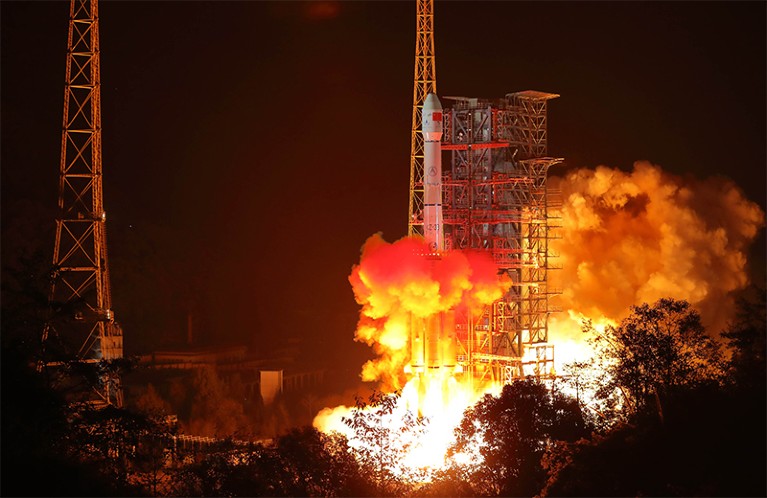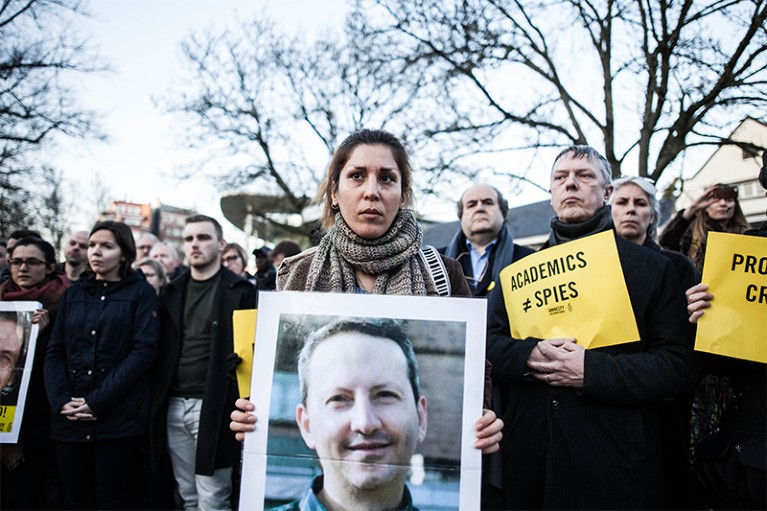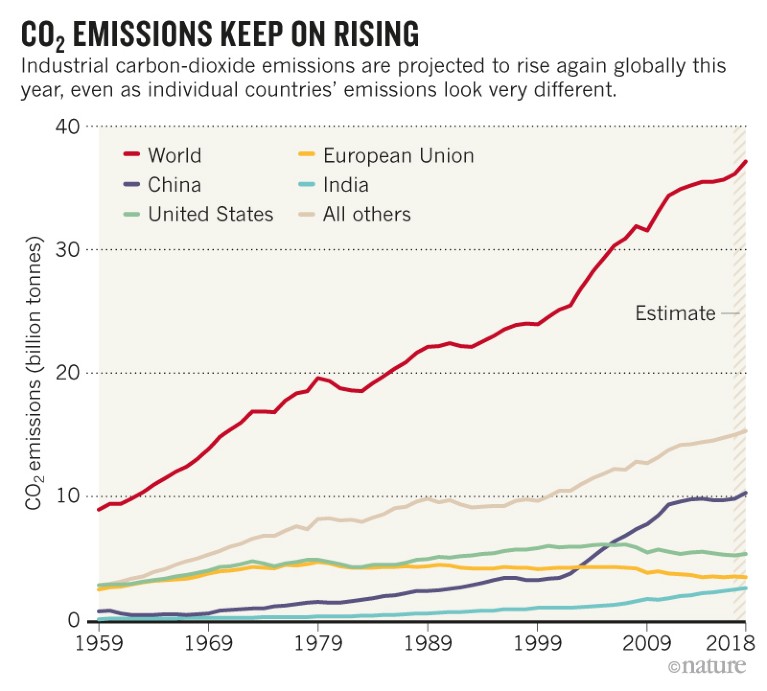EVENTS
Chang’e-4 sets off to the Moon’s far side China’s Chang’e-4 spacecraft, which is bound for the Moon’s far side, successfully lifted off from the Xichang Satellite Launch Center in Sichuan province on 8 December. The craft, carrying a lander and a rover, aims to be the first to ‘soft’ land on the Moon’s crater-filled far side. The rover will survey its surroundings, and the lander will carry out several experiments, including testing whether plants can grow on the Moon. “Everything appears to have worked flawlessly,” says Robert Wimmer-Schweingruber, a physicist at the University of Kiel, Germany, who has a radiation-detection experiment on the lander. Although the landing date has not yet been officially announced, Chang’e-4 is expected to attempt to touch down on the Moon’s surface early next month. The site will probably be inside a 186-kilometre-wide crater called Von Kármán.

China's Chang’e-4 lunar probe launch.Credit: Xinhua via Zuma
Forests in 3D A NASA instrument that will map the world’s temperate and tropical forests in three dimensions launched to the International Space Station on 5 December. The Global Ecosystem Dynamics Investigation (GEDI) will use an advanced laser to analyse the heights of trees, shrubs and other foliage to gather information about the amount of carbon contained in Earth’s forests. Scientists hope that GEDI will give them a much better picture of the planet’s carbon sources and sinks. The instrument was launched aboard a SpaceX rocket with other scientific equipment, as well as 40 mice for a study about ageing. The launch, originally scheduled for 4 December, was delayed by a day to replace mouse food that had gone mouldy.
SPACE
Voyager milestone NASA’s Voyager 2 spacecraft has crossed into interstellar space, joining its twin — Voyager 1 — which made the passage in 2012. Both probes now sail beyond the reach of the Sun’s influence, as humanity’s most distant emissaries. Voyager 1 is 21.6 billion kilometres from the Sun. Voyager 2 is 18 billion kilometres away, and crossed the boundary on 5 November, said Ed Stone, Voyager’s project scientist based at the California Institute of Technology in Pasadena. He made the announcement on 10 December at a meeting of the American Geophysical Union in Washington DC.
RESEARCH
Earthquake risk Three new maps reveal which parts of the globe are most at risk of earthquakes — and where most people are vulnerable to seismic disaster. The charts, released on 5 December, are the culmination of a years-long effort coordinated by the Global Earthquake Model (GEM), a non-profit organization in Pavia, Italy, that works with emergency-management officials, geological surveys and disaster-preparedness groups worldwide. The first map, of global seismic hazard, shows which parts of the globe are prone to earthquakes. The second, of global seismic risk, highlights areas where buildings are likely to be damaged by ground shaking, and the third, of global exposure, looks at the number of buildings around the world — emphasizing the danger in highly populated regions.
POLITICS
Detained scholar A group of 121 Nobel laureates has written an open letter to Iran’s supreme leader calling for the release of Ahmadreza Djalali, a disaster-medicine scholar who has been sentenced to death in the nation. The letter was distributed to participants of the Nobel prize ceremony in Stockholm on 10 December by the human-rights group Amnesty International. It says that Djalali’s health is declining rapidly. The researcher, who worked at the Karolinska Institute in Stockholm, was arrested in April 2016 on spying charges during a visit to Iran. He was sentenced after a trial in Iran’s revolutionary court. Djalali denies the charges.

People protesting with photos of Ahmadreza Djalali.Credit: Kevin Van den Panhuyzen/Zuma
POLICY
Emissions limits The US Environmental Protection Agency (EPA) has announced plans to weaken the greenhouse-gas emissions standards for new, modified or reconstructed power plants. The proposed changes, released on 6 December, would replace regulations that effectively require any new or substantially modified coal-fired power plants to be equipped with the technology to capture and store carbon dioxide emissions. Opponents of the regulations, put in place under then-president Barack Obama, have argued that carbon-capture technology is too expensive and not commercially viable. The plan is the latest attempt by the administration of President Donald Trump to roll back climate policies implemented under Obama. The administration has already sought to scale back greenhouse-gas emissions standards for existing power plants and cars.
Moral code for AI Around 530 people have signed up to a set of ethical guidelines for the development of artificial- intelligence (AI) technologies. The University of Montreal and the Quebec Research Fund spent a year devising the list of principles, known as the Montreal Declaration, with the help of the general public, sociologists and policymakers. The ten principles include respecting privacy and ensuring that systems are democratic, equitable, responsible and designed to make sure that everyone in society benefits from AI. Most of those who have signed the declaration work in Canada or France.
Space agency The Philippines is a step closer to creating a national space agency. On 4 December, lawmakers in the country’s lower house of congress unanimously approved a bill to establish an institution to shape national space policy. The bill now needs to pass a vote in the upper house. If created, the agency will focus on space science and technology applications that could address national issues, such as disaster-risk reduction. The space agency will be the country’s official representation in the international space community. Although the Philippines already has space-related research and development initiatives, these are distributed between several national and private agencies. In 2015, the country established the National SPACE Development Program, led by astrophysicist Rogel Mari Sese, to jump-start the growth of space-science research. Since 2016, another programme to develop microsatellites has launched two into space to help map and monitor the Philippines for hazards, and it has launched a cube satellite for communications.
PEOPLE
UK science minister The UK government appointed a new science minister, Chris Skidmore, on 5 December, after Sam Gyimah resigned from the post over Brexit negotiations. Skidmore takes over responsibility for the universities and science portfolio, which is split between the education and business departments; he is the United Kingdom’s fifth science minister since 2010. Skidmore represents a constituency in southwestern England that hosts a national research centre on composite science, and he served as an adviser to former science minister David Willetts. Gyimah resigned over Prime Minister Theresa May’s politically divisive Brexit divorce deal, which defines the terms of Britain’s looming exit from the European Union. On 10 December, May delayed a crucial vote on the agreement in the face of major opposition to the plans among members of the UK Parliament. She said that she hopes to amend the deal to address their concerns.
Topology pioneer Theoretical physicist Shoucheng Zhang, a pioneer in the study of topological states of matter, died on 1 December, aged 55. Zhang, who was at Stanford University in California, was among the first physicists to predict that some materials known to be insulators should be able to conduct electricity on their outer surface. Such effects should arise because the quantum states of electrons can form shapes that are robust under perturbation, like knots on a string that can be pulled and twisted but not undone. These features are described by the mathematics of topology, and the materials are dubbed topological insulators. Zhang worked with others to confirm his predictions in the lab, and received several prizes for the work. Born in Shanghai, China, in 1963, he studied in Germany and the United States.
TREND WATCH
Global industrial emissions of carbon dioxide are likely to have risen by 2.7% in 2018 to reach an all-time high, an international consortium of scientists reports. This marks a second year of strong growth after a brief period of relatively stable emissions.
The findings were released by the Global Carbon Project on 5 December at the 24th Conference of the Parties to the United Nations Framework Convention on Climate Change (COP24) in Katowice, Poland — and they underscore the challenge of reining in fossil-fuel consumption. The scientists also said that deployment of renewable energies such as wind and solar power is increasing rapidly around the world, but not fast enough to displace coal use in places such as India and China or a growing global demand for oil and natural gas. Industrial CO2 emissions are likely to hit an all-time high of 37.1 billion tonnes this year. The total CO2 emissions, including those from deforestation and other activities on land, will reach 41.5 billion tonnes — also the highest since records began. The biggest driver of emissions growth is a rise in fossil-fuel emissions in China, which accounts for more than 46% of the projected increase.






